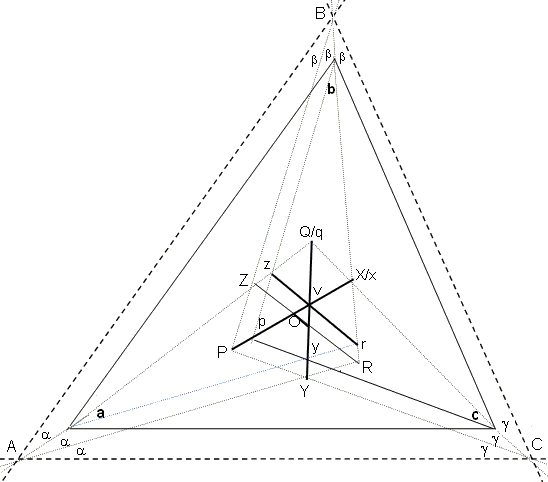Morley's Theorem, a Proof
Brian Stonebridge (University of Bristol, UK)
January 30, 2009
In the diagram below, the near trisectors of the internal angles at the vertices A, B, and C of a triangle meet in X, Y, and Z. Morley's theorem states that the triangle XYZ is equilateral. We give here a direct Euclidean proof.

Using the notation in the diagram, since, in ΔABC,
| (1) | α + β + γ = π/3. |
From triangles BPC, CQA, ARB,
| (2) |
|
Observe that, in ΔBPC, X is the intersection of the bisectors of angles at B and C. It follows that PX is the bisector of the angle at P. Thus,
| (3) |
|
This result holds for any other pair of diagonals PX, QY, RZ.
Assume that the diagonals are not concurrent, and thus form a triangle.
Select a diagonal, RZ, say, and, through the opposite vertex v, draw rz, parallel to RZ, with z, r on QA, RB. Then, Δzvq, Δxvq are congruent (ASA). Choose y, p so that Δxvr, Δyvr are congruent (ASA) making
| (4) | vz = vx = vy, |
and ∠vpy = ∠OPY so that Δvpy, Δvpz are congruent (SAA). Then the angles of pzqxry, PZQXRY are the same.
Joining opposite sides of pzqxry we obtain Δabc, with angles 3α, 3β, 3γ and its trisectors which generate Δxyz.** Triangles
** Informally," the mapping pzqxry ↔ abc is 1-1" suffices, but more formally the derivation of this result is as follows:
The intersections of opposite sides of pzqxry give Δabc. Since
Morley's Miracle
On Morley and his theorem
- Doodling and Miracles
- Morley's Pursuit of Incidence
- Lines, Circles and Beyond
- On Motivation and Understanding
- Of Looking and Seeing
Backward proofs
- J.Conway's proof
- D. J. Newman's proof
- B. Bollobás' proof
- G. Zsolt Kiss' proof
- Backward Proof by B. Stonebridge
- Morley's Equilaterals, Spiridon A. Kuruklis' proof
- J. Arioni's Proof of Morley's Theorem
Trigonometric proofs
- Bankoff's proof
- B. Bollobás' trigonometric proof
- Proof by R. J. Webster
- A Vector-based Proof of Morley's Trisector Theorem
- L. Giugiuc's Proof of Morley's Theorem
- Dijkstra's Proof of Morley's Theorem
Synthetic proofs
- Another proof
- Nikos Dergiades' proof
- M. T. Naraniengar's proof
- An Unexpected Variant
- Proof by B. Stonebridge and B. Millar
- Proof by B. Stonebridge
- Proof by Roger Smyth
- Proof by H. D. Grossman
- Proof by H. Shutrick
- Original Taylor and Marr's Proof of Morley's Theorem
- Taylor and Marr's Proof - R. A. Johnson's Version
- Morley's Theorem: Second Proof by Roger Smyth
- Proof by A. Robson
Algebraic proofs
Invalid proofs
|Contact| |Front page| |Contents| |Geometry|
Copyright © 1996-2018 Alexander Bogomolny
73541638
